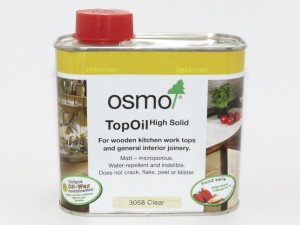Kitchen worktop oil
Deciding which kitchen worktop oil to use is always a hot topic on DIY forums, with discussions normally providing plenty of conflicting advice covering everything from product preferences, to number of coats, to application methods. As a result of all these differing ideas and options, I would imagine that most readers leave the forum more confused than ever, and still concerned about what the best options actually are. Well for me, there is one product out there that far outperforms all the other options, and ever since it came onto the market, and my local decorator’s merchant gave it his recommendation, it’s the only worktop oil I have used, or will use.

Water-repellent, indelible, based on natural vegetable oils and waxes…….and a fantastic longlasting finish!
The product is called Top Oil and is manufactured by a company called Osmo. What makes it stand out from the competition is firstly the fact that it isn’t actually just an oil, as it is in fact a combination of oil and wax. Therefore in terms of how it looks, it has a slightly waxy sheen that I’ve never found with any other type of worktop treatment. Not only does this look great, but it also feels smoother to the touch.
Crucially, you can also get a very matt finish with this wax/oil combination. Many kitchen worktop oils provide far too much of a sheen for my liking and has the effect of turning a natural wooden product into something less authentic looking, which just seems crazy to me.
Applying worktop oil
In terms of application, as always, follow the manufacturer’s guidelines precisely, but in brief, firstly you follow all the usual preparation techniques of sanding and cleaning down the surface. You then need to use a fairly stiff natural bristled brush for application (Osmo also supply these), as the secret to getting a good finish is in applying the oil as sparingly as possible. You literally spread it as thinly as you can, with the grain, making sure you leave no excess on the wood surface. Leave the first coat to dry overnight before applying your second coat. I always tend to give the surface a very light sand with fine sandpaper (150-180 grit) between coats, and a wipe off to remove all the dust. Two coats are all that is required, although I often do a third, just to make it even more hardwearing.
How long does worktop oil last?
With all finished wooden worktops, there comes a time when they need sanding back and re-coating, but of all the oils I’ve used, the Osmo finish outlasts the rest by far. Some worktop oil manufacturers recommend re-coating after periods of anything from a few months to a couple of years. With the Osmo oil, because it is so water repellent and resistant to staining, you can literally wait four to five years until it’s time to re-coat (I’ve just sanded back and re-coated my kitchen worktops after over 5 years, and they look as good as new).
Where to buy worktop oil
As far as I know, you won’t find Osmo Top Oil in any of the major DIY outlets. Therefore it’s best to go to the Osmo website, in order to find your nearest supplier, or, you can also find the Osmo range on Amazon. I always use the clear matt Top Oil, but you will find they also do a ‘Natural’ or ‘Acacia’ finish, if you want to add a bit of colour.
So the next time you need to oil a worktop, don’t waste your time reading about the pros and cons of linseed, tung, Danish, or indeed any other type of oil, just go straight for the Osmo Top Oil – you won’t regret it!
